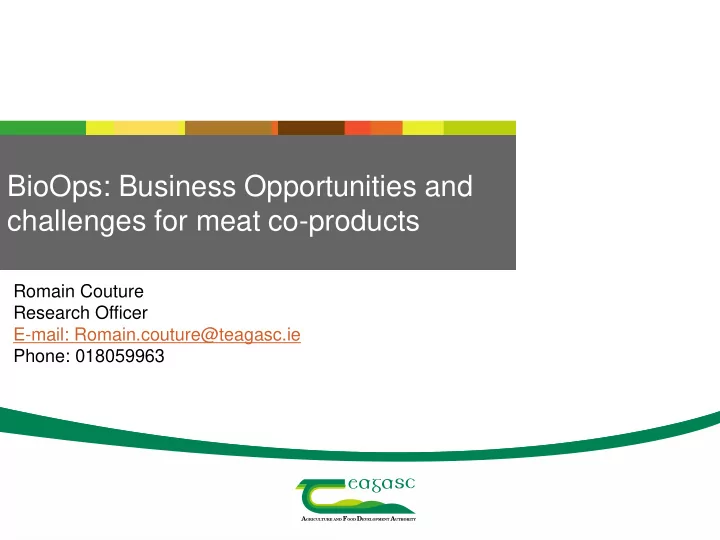

BioOps: Business Opportunities and challenges for meat co-products Romain Couture Research Officer E-mail: Romain.couture@teagasc.ie Phone: 018059963
BioOps – a DAFM-funded project • DAFM-funded project that aims at commercially evaluating opportunities from low-value streams from the meat processing chain. • The goal is to assess pathways to improve economical and environmental sustainability in the meat sector. 2 Teagasc Presentation Footer
BioOps - Methodology • Literature review – Scientific papers, market reports, legislation on animal by-products • Industry meetings to get global insights from professionals. (Ireland, France, Spain, Denmark, Belgium, USA, Australia…) • Selection of the most viable co-products. • Cost-benefit analyses. • Dissemination to decision makers through talks and reporting. 3 Teagasc Presentation Footer
Introduction 1,746,517 Bovines Substantial amount of Ireland, 2017 co-products generated 3,241,556 Porcines 4 Teagasc Presentation Footer
Introduction 5 Teagasc Presentation Footer
Introduction Edible Co- products Cat 2 : Products destined to fertiliser or bioenergy uses Cat 3 : by-products Cat 1 : Specified intended for animal Risk Material feed or pet food 6 Teagasc Presentation Footer
Two main co-products chosen Blood Lungs 7 Teagasc Presentation Footer
WHY? 8 Teagasc Presentation Footer
Three main factors • Volume • Applications • Existing knowledge 9 Teagasc Presentation Footer
The Value Hill Model (Achterberg, Hinfelaar and Bocken 2016) take away blue table, use practical co-product case instead) Much simpler Circular design Use of the product Recovery of Value Hygienic processes Slaughtering and Harvesting meat On entire chain harvesting of meat co-products and giving them new uses Network Organisation 10 Teagasc Presentation Footer
Blood Species Number of Litres of blood per Litres of blood Total slaughter/year animal (unhygienic) per animal production (kgs) (hygienic) (kgs) (tonnes) Porcine 3,241,556 4 3.2 10,372 Bovine 1,746,517 18.5 12 20,958 11 Teagasc Presentation Footer
Blood processing Fractionation 12 Teagasc Presentation Footer
Blood Proteins Properties Functional properties OHC Compound Emulsifying Solubility Gelling (LHC) WHC 3.13±0.07 Haemoglobin Medium High 10% Nd 8.72±0.05 Blood plasma Very high High 6% 6.52±0.51 Nutritional properties Product Leu Ile Lys Met Cys Phe Tyr Trp Thr Val His Whole 13.2 0.9 9.7 2.4 n.d. 10.7 1.4 1.5 4.8 8.7 8.8 blood Plasma 9.34 3.35 7.47 0.86 1.68 5.16 4.78 1.18 6.60 6.73 4.18 RBC 13.92 n.d 10.37 0.36 n.d 8.19 2.39 n.d 5.11 8.5 6.38 13 Teagasc Presentation Footer
Blood potential uses Pharmaceutical Uses Human Food Pet Food Animal Feed Fertiliser 14 Teagasc Presentation Footer
Challenges Opportunities BSE Crisis • There is still distrust in the market (bovines) More stringent regulations. Legislation • Legislation is very strict Use it as an advantage to prove your point. Consumer acceptance • Negative ideational factors Blood as a food ingredient to remove E- numbers. Replacers for pet food / animal feed • What will be fed to animals if humans use these products New protein sources. 15 Teagasc Presentation Footer
Lungs Species Number of Average weight of Total production slaughter/year lungs per animal (tonnes) (kgs) Porcine 3,241,556 1 3,241 Bovine 1,746,517 3.5 6,113 16 Teagasc Presentation Footer
Lungs Processing Soluble proteins + Proteins water buffer (120g) pH shift + centrifugation Water (9/10) Lung extract Separation paste Pure Wash collagen Pellets of Collagen Lungs (1/10) (60g) 17 Teagasc Presentation Footer
Lung Proteins Properties Functional properties from soluble fraction Gelling Co-product Emulsifying Solubility WHC OHC (LGC) Medium-low at 4-6 pH, Lung Very high 10-16% 5.95±2.00 4.63±1.8 very high at 9-11 pH Nutritional properties Leu Ile Lys Met Cys Phe Tyr Trp Thr Val His %EAA 7.3 4.8 7.1 2.0 1.5 4.1 2.2 0.9 3.7 4.9 3.0 41.5 18 Teagasc Presentation Footer
Lung proteins potential uses Pharmaceutical industry Functional Foods Protein source/ functional properties Pet Food 19 Teagasc Presentation Footer
Cost Benefit Analysis 4 main variables for ROI: » Production volumes : slaughter number, rejection rate, amount of final product. » Fixed assets : Property, plant and equipments. » Operational costs : Utilities (water, wastewater, labour, energy, steam…), Procurement (raw materials, additives) » Income : Wholesale price of products. 20 Teagasc Presentation Footer
Challenges Opportunities Negative sensory properties • Lungs have an unappealing texture Process to use it as a protein ingredient Scale • Need an efficient logistics system Collaboration amongst stakeholders to oversee the modalities Category 3 by-products • Cat 3 by-products Collection, inspection and storage systems have to abide by regulation. 21 Teagasc Presentation Footer
Outcomes of the project Return on Investment depend on several variables: kill number, rejection rate, upfront investments in machinery, retail price… Recovery of proteins from alternative sources is inevitable in the future. Your products are valuable. Proteins from co-products can be used as protein enhancers, functional proteins, functional foods, pharma uses, pet food… Cross-sectoral vertical collaboration along the value chain is key to develop commercial applications. 22 Teagasc Presentation Footer
Recommendations Personal recommendation: plenty of potential for coordinated Irish and European effort regarding recovery of value for co- products. There are new markets to explore and value to be recovered at many stages along the value chain. It is important to know your products potential applications, and to talk with your buyers about their uses. Try to find short-circuits applications before setting up complicated systems. Using co-products as protein ingredients for protein enriched foods, and as functional ingredients in recipes and food manufacturing, are viable markets to pursue. Carry on the research on functional foods. Work in a collective effort instead of individual actions. 23 Teagasc Presentation Footer
Thank you for your attention 24 Teagasc Presentation Footer
Recommend
More recommend